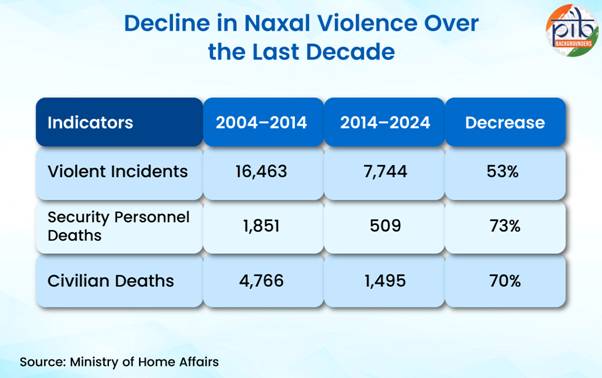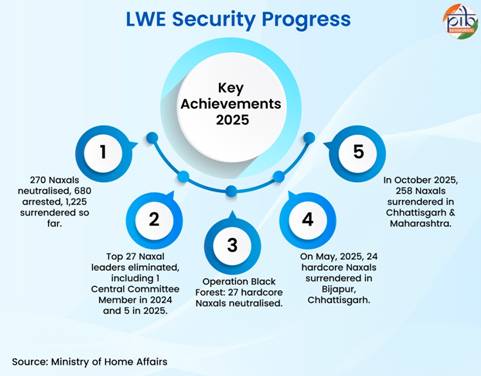Others
Union Government’s Comprehensive Strategy against Naxalism
Posted On:
25 OCT 2025 15:33 PM
A Decade of Decisive Action: From Violence Reduction to Development and Reintegration

Introduction
The Union Government has transformed India’s counter-Naxal strategy through an integrated approach combining security, development, and rehabilitation. Abandoning fragmented responses of the past, the central government adopted a unified plan rooted in Dialogue, Security, and Coordination, aiming to make all affected districts Naxal-free by March 2026.
This approach focuses equally on law enforcement efficiency, capacity building, and social integration, marking a paradigm shift from reactive containment to proactive elimination.
A Decade of Decline in Naxal Violence
Over the last decade, the coordinated efforts of security forces and development initiatives have led to a significant fall in Naxal-related violence. Between 2004–2014 and 2014–2024, violent incidents dropped from 16,463 to 7,744, deaths of security personnel fell from 1,851 to 509, and civilian deaths declined from 4,766 to 1,495, a remarkable sign of restored peace and governance in affected regions.

In 2025 alone, security forces neutralised 270 Naxals, arrested 680, and facilitated 1,225 surrenders. Major operations such as Operation Black Forest and mass surrenders in Bijapur, Chhattisgarh, and Maharashtra underline growing confidence among insurgents to rejoin mainstream life.

Strengthened Security Grid and Technological Advancements
The government’s focus on security infrastructure has been pivotal. In the last decade, 576 fortified police stations have been built, and 336 new security camps have been established in the last six years. The number of Naxal-affected districts reduced from 126 in 2014 to 18 in 2024, with only 6 districts now categorised as most-affected. The expansion of night-landing helipads (68 constructed) has improved mobility and response times during operations.
Security agencies are now using cutting-edge technologies to ensure precise monitoring and analysis of Naxal activity. Tools such as location tracking, mobile data analysis, scientific call log examination, and social media analysis are being deployed for close observation of Naxal movements. Support from various forensic and technical institutes has further strengthened intelligence gathering and improved operational efficiency. Additionally, drone surveillance, satellite imaging, and AI-based data analytics are being effectively utilized to enhance monitoring and strategic planning.
Strategies to dismantle Naxal Finance Networks
Financial networks sustaining Naxalism have been systematically dismantled. A special vertical within the National Investigation Agency (NIA) has seized assets worth over ₹40 crore, while Enforcement Directorate (ED) operations led to confiscations worth ₹12 crore. States have also seized properties worth ₹40 crore. Additionally, urban naxals have suffered significant moral and psychological setbacks, leading to a decline in their capacity for information warfare.
Capacity Building and State Support
Empowering state forces has been a cornerstone of the government’s Left-Wing Extremism (LWE) policy. Under the Security Related Expenditure (SRE) scheme, ₹3,331 crore was released to LWE-affected states over the past 11 years, a 155% increase compared to the previous decade. The Special Infrastructure Scheme (SIS) approved ₹991 crore for strengthening state special forces, special intelligence branches, and the construction of Fortified Police Stations.
Since 2017–18, projects worth ₹1,741 crore have been approved, and ₹445 crore released so far. Under Special Central Assistance (SCA), ₹3,769 crore was dedicated to developmental projects in LWE districts, complemented by ₹122.28 crore under Assistance to Central Agencies (ACALWEMS) for camp infrastructure and ₹12.56 crore for health facilities.
Infrastructure Development
Development of critical infrastructure has accelerated social and economic inclusion in Naxal-affected areas.
- Road Connectivity: Between 2014 and 2025, over 12,000 km of roads were completed, with ₹20,815 crore approved for 17,589 km of total construction.
- Mobile Connectivity: The expansion of mobile connectivity in Left Wing Extremism (LWE)-affected areas has been implemented in two phases. Under Phase I, 2,343 (2G) towers were constructed at a cost of ₹4,080 crore. In Phase II, 2,542 (4G) towers were sanctioned with an investment of ₹2,210 crore in September–October 2022, out of which 1,139 have become operational.
Additionally, 8,527 (4G) towers have been approved for LWE-affected regions. Under the Aspirational Districts Plan, 2,556 of the 4,281 approved towers are functional, while under the 4G Saturation Plan, 2,602 out of 4,246 towers are operational.
- Financial Inclusion and Accessibility: 1007 bank branches, 937 ATMs, and 37,850 banking correspondents have been established. 5,899 post offices now operate across 90 districts, ensuring that every 5 km, citizens have access to postal and financial services.
- Education and Skill Development: Under Kaushal Vikas Yojana, ₹495 crore was sanctioned to set up 48 Industrial Training Institutes (ITIs) and 61 Skill Development Centres (SDCs) in 48 districts, of which 46 ITIs and 49 SDCs are operational. These institutions are providing new livelihood opportunities to the youth transitioning from conflict to development.
- Security and Enforcement: A total of 108 cases have been investigated, resulting in 87 charge sheets filed so far. The Bastariya Battalion, formed in 2018, comprises 1,143 recruits, including 400 youth from Bijapur, Sukma, and Dantewada districts, symbolizing local participation and trust-building in security operations.
Neutralising Naxal Network, Reclaiming Areas, and Ensuring Rehabilitation
Through sustained security operations and focused intelligence-based strategies, the Government has reclaimed several areas once under Left-Wing Extremist (LWE) influence for over three decades. The “Trace, Target, Neutralise” approach has been central to this success, enabling forces to identify and eliminate key Naxal leaders and disrupt their command structure. Operations such as Octopus, Double Bull, and Chakrabandha have achieved remarkable success in the fight against Naxalism, with the establishment of camps deep in remote areas.
As a result, regions like Budha Pahar, Parasnath, Baramsia, and Chakrabandha have been nearly freed from Left-Wing Extremism. Security forces have successfully entered Abujhmaad, the last major stronghold of the insurgents. Furthermore, the PLGA (People’s Liberation Guerrilla Army) was forced to abandon its core areas in Bijapur and Sukma. In 2024, the Naxals’ Tactical Counter-Offensive Campaign (TCOC) aimed against our security forces failed due to the effectiveness of our aggressive operations.
In 2024, security forces carried out 26 major encounters, resulting in the neutralisation of top Naxal cadres, including:
- 1 Zonal Committee Member (ZCM)
- 5 Sub-Zonal Committee Members (SZCM)
- 2 State Committee Members (SCM)
- 31 Divisional Committee Members (DVCM)
- 59 Area Committee Members (ACM)
This systematic action has dismantled several core groups and restored peace and governance in previously affected regions. Alongside security efforts, the Government’s Surrender and Rehabilitation Policy encourages cadres to return to mainstream society by offering livelihood and social support.
In 2025, 521 LWE cadres have surrendered so far, and in the last two years, 1,053 surrenders have been recorded in Chhattisgarh. Moreover, rehabilitated cadres receive financial assistance of ₹5 lakh (high-rank), ₹2.5 lakh (mid/low-rank), and a ₹10,000 monthly stipend for vocational training for 36 months, enabling them to rebuild their lives with dignity and stability.
Conclusion
Under the leadership of Prime Minister Narendra Modi, India’s fight against Naxalism has evolved into a comprehensive campaign rooted in security, development, and social justice. Through a combination of robust infrastructure, cutting-edge technology, targeted enforcement, and compassionate rehabilitation, the government has transformed once-conflicted regions into hubs of opportunity.
With sustained momentum and cooperation between the Centre and States, India is well on course to achieve its goal of becoming Naxal-free by March 2026, a testament to a decade of decisive governance and unwavering commitment to peace and development.
See in PDF
***
SK/GS
(Factsheet ID: 150426)
Visitor Counter : 16
Provide suggestions / comments
Read this explainer in :
हिन्दी